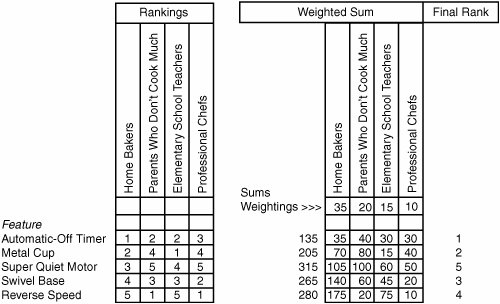How I Can Use 2020 Vision
Processing the ResultsProcessing the results of the 20/20 Vision game is often quite straightforward. You simply transcribe the final prioritized list, keeping track of significant choices relative to design continuums. The results are then used to inform your product road map, with higher priority features being delivered more quickly. After you've defined your market-facing priorities, you need to take this list to your development/engineering team and ask them to create a dependency list. You might find that, although your customer ranked a given feature low on their list of features, your technical team has identified it as an essential prerequisite to one or more of the more highly ranked features. As a result, you will find that the final list of features doesn't necessarily match the ranking provided by your customers. There are other considerations that you should include when preparing the final set of feature priorities. Consider the old adage that goes something like this: "If you try to please everyone, you'll end up pleasing no one." It is true. Keep in mind that each stakeholder affected by the product is likely to have a different ranking of features and that understanding these rankings is critical to producing an effective result. One technique that I find helpful in doing this is to create a spreadsheet that assigns weightings to features based on stakeholder prioritization and then computes a weighted sum across stakeholders. The advantage of this approach is that it allows you to include an arbitrary number of stakeholders, from customers (by direct customer or by market segment) to service, sales and support, distribution channels, strategic partners, and so forth.
Suppose, for example, that you're ranking features for a blender. You've played the 20/20 Vision game with four market segments, listed in order of importance: Home Bakers, Parents Who Don't Cook Much, Elementary School Teachers, and Professional Chefs. Your primary market segment is the home market, which by market size is roughly twice as large as the other markets. As a result, you weight the Home Baker so that their votes are the most influential in the process. (See Figure 2.22.) Figure 2.22. 20/20 Vision Market Feedback Putting the results into this kind of spreadsheet can be quite enlightening. In this simple example, we can see that while the Home Baker thinks that the Super Quiet Motor is the third most important potential feature, the other market segments consider it relatively unimportant. The weighted ranking results in this feature being the least important (lower numbers are better in the ranking). As the product manager, you can certainly still put the Super Quiet Motor higher than last place, but you'll be doing this with the knowledge that most of your market considers this to be a relatively unimportant feature. This may be the best choice, based on factors not shown in this small sample (see the sidebar on ranking features). As you can guess, playing around with weightings can produce different results, and the spreadsheet format typically gives you an easy way to explore these options. A final processing step concerns the handling of negotiations about the relative priority of each feature. It is useful to examine observer cards about which customers negotiated most passionately about the relative ranking of a given feature, as this gives insight into individual customer and customer segment preferences. |
EAN: 2147483647
Pages: 144
- ERP Systems Impact on Organizations
- ERP System Acquisition: A Process Model and Results From an Austrian Survey
- The Effects of an Enterprise Resource Planning System (ERP) Implementation on Job Characteristics – A Study using the Hackman and Oldham Job Characteristics Model
- Healthcare Information: From Administrative to Practice Databases
- Development of Interactive Web Sites to Enhance Police/Community Relations